By Nick Atkins
On February 29th, I received the email. I had been accepted into the MUNY/Webster Intensive, a three-week musical theatre intensive in St. Louis, Missouri. (MUNY is short for the Municipal Theatre Association of St. Louis.) I would participate in workshops, take classes at Webster University, and 0perform in the MUNY’s production of Mamma Mia with professional Equity actors in front of 10,000 people a night.
Four months earlier, Waco High’s Technical Theatre Director, Cory Garrett, asked me to audition. He believed I could best represent not only Waco High, but also Waco itself. So I began the application process, including preparing three separate videos—a monologue, a song, and a dance performance. I didn’t know at the time that only eleven students from across the country would be selected.
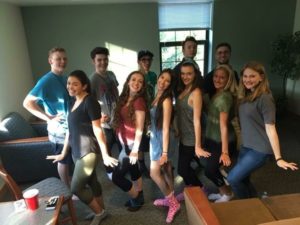 When I walked in to the boys’ dorm, I found myself greeted with high fives, handshakes, and stories of our hometowns. Alex from Canada, Harrison and Miller were both from Kentucky, and the other Harrison was also from Texas. We were told to go to the living room for a “team meeting.” While we were waiting for the girls, we heard thundering from the hallway. From around the corner, six girls came in, squealing in excitement that the last of the group had finally shown up. Brooke and Becca were from Florida, Karissa and Rachel lived in California, Tori was from a small town outside Boston, and Anika was a Rhode Island girl. Of my three weeks in St. Louis, that first day was one of the best. We all sat there in a circle, learning about each other, telling stories from our hometowns, listing the roles we had played in performances. It was that night that I realized how close theatre really brings people together. We all came from different places, different backgrounds.
When I walked in to the boys’ dorm, I found myself greeted with high fives, handshakes, and stories of our hometowns. Alex from Canada, Harrison and Miller were both from Kentucky, and the other Harrison was also from Texas. We were told to go to the living room for a “team meeting.” While we were waiting for the girls, we heard thundering from the hallway. From around the corner, six girls came in, squealing in excitement that the last of the group had finally shown up. Brooke and Becca were from Florida, Karissa and Rachel lived in California, Tori was from a small town outside Boston, and Anika was a Rhode Island girl. Of my three weeks in St. Louis, that first day was one of the best. We all sat there in a circle, learning about each other, telling stories from our hometowns, listing the roles we had played in performances. It was that night that I realized how close theatre really brings people together. We all came from different places, different backgrounds.
The next two weeks were hectic, sweaty, and amazing. Every morning, we’d all wake up, get dressed in whatever our color of the day was, and head to rehearsal at 10 o’clock. The eleven of us were in the ensemble, meaning we learned the music for every song, and were on stage numerous times dancing. One day I was on the side of the rehearsal studio waiting for my cue to come on. There was an adult Equity ensemble member waiting with me named Kevin Zak. He noticed how quiet I was and decided to make some conversation. We started talking about theatre and how we got into it. I jokingly asked how many Broadway shows he had been in and he answered with, “Well I was in the original Off-Broadway Cast of Clinton: The Musical.” My jaw dropped. I asked him what part he played. Ken Starr. I met the man that played Ken Starr in Clinton: The Musical.
Our evenings were different each night. We got to see the MUNY’s production of both The Music Man and Young Frankenstein. We had three workshops and got to work on our college audition pieces with choreographer Josh Rhodes, actress Julia Murney, and actress Nancy Opel. One night, we went to a place called The City Museum. At first, I just expected a history museum with exhibits pertaining to St. Louis, but it was actually a giant playground. Three glorious stories of mazes, jungle gyms, and slides. We were all so tired after that, we totally forgot about our midnight tech rehearsal that next day.
At the MUNY, the musicals have two weeks to rehearse and one week of performance. When a show ends, the next musical has a “midnight tech” rehearsal in which the sound, lighting, and set elements are put to the test just hours before the opening. The Mamma Mia midnight tech rehearsal went so smoothly, we were headed home around 11:45. That afternoon, the cast got together for “sweat tech”, a last minute run through of the show in the sweltering St. Louis afternoon.
 Then came the fun part. Opening night. We arrived thirty minutes early to get our microphones and costumes ready, and headed to our places. For most of us, our first dance number wasn’t until a few scenes into the show, but a few of them were in the opening scene. After that first scene, they came back with their jaws dropped. It was packed. 11,000 seats, filled to the brim. My first number, “Lay All Your Love”, where I waddled onstage with four other guys in flippers and goggles and did a little dance in front of two leads, I glanced out to the crowd to get a good look and I nearly forgot my dance and stopped right there. I had never seen that many people in an audience. It was truly beautiful.
Then came the fun part. Opening night. We arrived thirty minutes early to get our microphones and costumes ready, and headed to our places. For most of us, our first dance number wasn’t until a few scenes into the show, but a few of them were in the opening scene. After that first scene, they came back with their jaws dropped. It was packed. 11,000 seats, filled to the brim. My first number, “Lay All Your Love”, where I waddled onstage with four other guys in flippers and goggles and did a little dance in front of two leads, I glanced out to the crowd to get a good look and I nearly forgot my dance and stopped right there. I had never seen that many people in an audience. It was truly beautiful.
During the performance week, we took classes at the Webster campus during the day. We all referred to it as “Webster Week”. We took yoga, improv, dance, and acting classes. Lara Teeter, the head of the musical theatre program at Webster, worked with us on college audition pieces alongside Tim Ocel and Ron McGowan. Together, they helped us with every aspect of Musical theatre. I learned things that week that I can use in any part I play. I have already used some of the tips for my part in Waco High’s production of The Little Mermaid.
T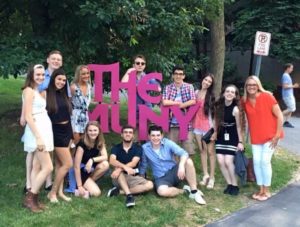 he one question I always get when talking about this trip is, “What was your favorite part?” That becomes harder and harder to answer every time I look back on it. I learned a lot in the Webster classes, and had a blast performing in Mamma Mia. However, those memories would not have been so amazing if not for the other ten people that were with me 24/7. These people are lifelong friends. Some of the most fun times were at the dorms after rehearsal when we crashed on the couches and talked. We shared every meal together. We would stay up late just to practice dances together so we knew we had it down. These ten people are all so talented; I have no doubt in my mind that they will all do amazing things in the future, not necessarily in acting. They aren’t just great actors, great singers, or great dancers. They are all great people. In our workshop with Julia Murney, she said something that stuck with all of us: “You’re worth more than a 5, 6, 7, 8”.
he one question I always get when talking about this trip is, “What was your favorite part?” That becomes harder and harder to answer every time I look back on it. I learned a lot in the Webster classes, and had a blast performing in Mamma Mia. However, those memories would not have been so amazing if not for the other ten people that were with me 24/7. These people are lifelong friends. Some of the most fun times were at the dorms after rehearsal when we crashed on the couches and talked. We shared every meal together. We would stay up late just to practice dances together so we knew we had it down. These ten people are all so talented; I have no doubt in my mind that they will all do amazing things in the future, not necessarily in acting. They aren’t just great actors, great singers, or great dancers. They are all great people. In our workshop with Julia Murney, she said something that stuck with all of us: “You’re worth more than a 5, 6, 7, 8”.
Nick Atkins is currently a senior at Waco High School. He is involved with the varsity choir, show choir, theatre program, NHS, and mascot at WHS. He would like to thank his family and all of his directors for giving him the courage to pursue theatre. After high school Nick plans on getting a BFA in Musical Theatre.
By Ashley Bean Thornton
(Warning: Really bad metaphor ahead! Don’t read if you are sensitive to overwrought literary conceits.)
For my fortieth birthday I bought myself a ukulele. Except for a few dutiful piano lessons in Jr. High, I had never played an instrument. I thought it might be interesting to celebrate middle age by stretching my brain in a new direction. I picked ukulele because…4-strings… how hard could it be?
I was partly right. Playing the ukulele wasn’t all that hard. In fact, with a little practice, I had a great time playing it! I fell in with a few goofy friends from Baylor and we formed a little ukulele band. (The “Free to Be Uke” Players — get it?) We had a blast! We even did a little Christmas sing-a-long in the Student Union Building much to the – delight? bemusement? annoyance? – of the students passing by on their way to take their final exams.
The hard part about the ukulele wasn’t learning how to play it, it was learning how to tune the darn thing. This was so frustrating to me that sometimes I tried to skip the tuning and just play…but, it sounded terrible, and that wasn’t any fun. Usually (probably out of a desire to preserve his own sanity) my much-more-musical-than-me husband would end up volunteering to tune it for me. I would hand it over, and he would patiently pluck each string, listening carefully while he tightened and loosened first one then another until finally – magically, it seemed to me — he would strum a few chords, and it would all sound good together.
I haven’t played my ukulele in a few years now, but I still think pretty often about the notion of “tuning.” Tuning is hard to do, but it’s a simple idea really. A string is stretched between two end points. The quality of the music depends on finding and maintaining the right tension between those end points.
It’s interesting (at least to me) to note that no one would ever say that one or the other end point between which the ukulele string is stretched is “right” or “wrong.” That doesn’t even make any sense. Both end points are necessary. The tension between them is what makes the music possible, and adjusting that tension is what makes the music sound good or bad.
It’s a simple idea, but I had never thought about it before, and it struck me as pretty profound. It helps me understand what is necessary when two true and good things seem to be opposed to each other – a condition that comes up constantly.
Think of all the pairs of “end points” you tune between on a regular basis in your personal life: striving and resting, independence and interdependence, confidence and humility… One end point isn’t “right” and the other “wrong.” They are both important. We have no choice but to take on the sometimes frustrating, sometimes rewarding task of loosening, tightening and listening to get the tension right between them so that the music of our lives sounds good.
I’m thinking about all this today because I just got home from a weekend trip to Austin to attend a thing called “Tribfest.” It’s basically an annual 3-day political “wonk-fest” put on by The Texas Tribune, my favorite news source for all things having to do with Texas politics. Tribfest is billed as “your chance to engage with politicians, industry leaders and journalists as they explore issues critical to Texas.” While there I got to hear, among other things, interviews with John Kasich and Ted Cruz, and bi-partisan panel discussions on all kinds of topics from the STAAR test to the appropriate relationship between faith and government. The conversations were by turns fascinating, frustrating, terrifying and hopeful.
Throughout the weekend, the idea of “tuning” has been playing in the back of my mind. The whole Tribfest was full to the brim with examples of the exact kinds of things I’m talking about above — true and good ideas that seem opposed to each other:
- Personal freedom/public good…
- Regulations to protect our environment/flexibility to do business in a profitable way…
- Giving our teachers the freedom to teach/holding our school systems accountable for learning…
- Wise frugality/ wise investment…
- Protecting second amendment rights/Protecting ourselves against gun violence…
The most hopeful conversations I heard were the ones where our leaders (elected and otherwise) seemed to understand the notion of tuning – where they understood that both end points are necessary to make the music and we have to tighten and loosen and listen until we find the right pitch.
The most discouraging and even scary conversations were the ones where the players didn’t seem to understand how the instrument worked at all, much less how to tune it. In these conversations the misguided leaders seemed bent on convincing us that the tension between the two end points was bad, and that whichever end point they stood on, the other end point had no value at all.
My weekend at Tribfest has left me wondering if “we the people” are taking enough responsibility for keeping our “ukulele of democracy” in tune. (Did I warn you there was a terrible metaphor coming? Why, yes, I did…)
What is our part? We can reject the nonsensical and dangerously simplistic notion that our most complex political challenges are simple binary choices – that one end point is good and the other is bad. We can stop talking that way among ourselves, and we can stop cheering for that kind of talk from our leaders.
We can develop habits of thought more appropriate for the complex nature of the challenges we face. We can learn to tighten and loosen and listen in our own conversations, and we can support leaders who do the same. The political discourse in Texas, and in the country sounds terrible right now…and that’s no fun. Tuning is hard work, but it’s necessary to turn this noise into something that we can stand to listen to, much less sing along.
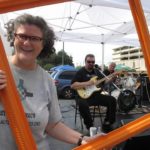 This Act Locally Waco blog post is by Ashley Bean Thornton, she works at Baylor, helps out with Act locally Waco, and facilitates the Waco Foundational Employment Network which is a part of Prosper Waco. She likes to walk and doesn’t mind at all if you honk and wave when you see her.
This Act Locally Waco blog post is by Ashley Bean Thornton, she works at Baylor, helps out with Act locally Waco, and facilitates the Waco Foundational Employment Network which is a part of Prosper Waco. She likes to walk and doesn’t mind at all if you honk and wave when you see her.
The Act Locally Waco blog publishes posts with a connection to these aspirations for Waco. If you are interested in writing for the Act Locally Waco Blog, please email [email protected] for more information.
By Joel H. Scott, Ph.D.
With a rich history of critically considering how faith informs hunger alleviation while nurturing people, the land, and community, World Hunger Relief, Inc, (WHRI) is a robust, life-giving organization. As the new Director of Development & Outreach, it’s my privilege to share with Act Locally Waco followers about one of the more unique not-for-profits in the United States.
So what’s WHRI? (affectionately know as “the Farm”)
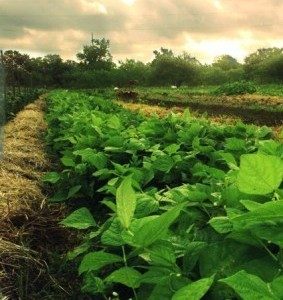 WHRI is a faith-based organization committed to the alleviation of hunger both locally and around the world.
WHRI is a faith-based organization committed to the alleviation of hunger both locally and around the world.
For 40 years WHRI has been training individuals in holistic ministry that equips for work with communities in developing sustainable agriculture, motivating individuals and communities to live sustainably and advocate on behalf of the poor, and partnering with like-minded organizations to address hunger related issues facing our local and global communities.
Where is it?
Our Physical Address is 356 Spring Lake Rd Waco, TX 76705. We are located on 40 acres just north of Waco off Hwy 77 (From I-35 Exit 342B).
So what does this training, motivating, and partnering really mean for Waco today? (Read on! The following is a snapshot of our mission in action)
 Training: WHRI has individuals from all over the world who serve as interns or live-in volunteers for 13 months and train in sustainable agriculture, spiritual development, and community engagement. WHRI has trained more than 350 interns working in 20 countries spanning 4 continents. Interns work for various domestic international organizations promoting sustainable food production and economic development. Many graduate and work for agencies in our greater Waco community such as intern Bethel Erickson-Bruce who pioneered the widely popular Waco Downtown Farmers Market in 2011.
Training: WHRI has individuals from all over the world who serve as interns or live-in volunteers for 13 months and train in sustainable agriculture, spiritual development, and community engagement. WHRI has trained more than 350 interns working in 20 countries spanning 4 continents. Interns work for various domestic international organizations promoting sustainable food production and economic development. Many graduate and work for agencies in our greater Waco community such as intern Bethel Erickson-Bruce who pioneered the widely popular Waco Downtown Farmers Market in 2011.
Currents interns represent several U.S. states and South Africa. This fall interns will be coming to train at the Farm from our international partnerships in Liberia and El Salvador.
Motivating/Educating: Each year, dozens of local organizations and faith communities (all ages) come to the Farm to wrestle with issues of food insecurity, corruption, and unequal distribution through our “Living on the Other Side” (LOTOS) experiential education exercises. Groups are empowered to consider responsible ways to alleviate modern day issues such as food deserts in their own communities.
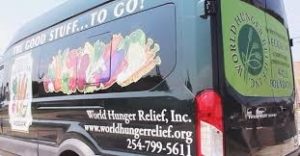 The Veggie Van: WHRI’s mobile food source, launched in 2014 to provide high quality, affordable vegetables in identified food deserts in Waco. In that time, WHRI has built relationships in the local food system (i.e. the farmer’s market vendors, other non-profits, local businesses, government officials, etc.) to reach some of the most vulnerable populations in Waco—senior citizens, the working poor, children from generational poverty and those living in underserved neighborhoods. The Veggie Van also serves as mobile educational tool for promoting awareness of local food deserts.
The Veggie Van: WHRI’s mobile food source, launched in 2014 to provide high quality, affordable vegetables in identified food deserts in Waco. In that time, WHRI has built relationships in the local food system (i.e. the farmer’s market vendors, other non-profits, local businesses, government officials, etc.) to reach some of the most vulnerable populations in Waco—senior citizens, the working poor, children from generational poverty and those living in underserved neighborhoods. The Veggie Van also serves as mobile educational tool for promoting awareness of local food deserts.
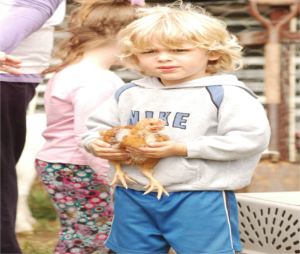 Farm Camp: During the summer, WHRI introduces Waco area children to the wonders of simple living, sustainable agriculture. Through this camp, children get to try new foods – picked fresh and warmed by the summer sun – and create a new relationship with food and the land. For more information about next year’s camp, please check out our website after February 1, 2017.
Farm Camp: During the summer, WHRI introduces Waco area children to the wonders of simple living, sustainable agriculture. Through this camp, children get to try new foods – picked fresh and warmed by the summer sun – and create a new relationship with food and the land. For more information about next year’s camp, please check out our website after February 1, 2017.
Guided Educational Tours: Over 1,300 folks visited the Farm last year on tours. WHRI has tours tailored to meet a variety of interests. We customize farm visits to fit curriculum, TEKS requirements, or learning objectives of any age or grade. We encourage visitors to consult the staff at WHRI before your visit and plan your farm experience; this can include service projects, meaningful work experiences, and pre/post-visit interactions.
Partnering: WHRI’s School Gardening Program partners with Waco ISD and local organizations in developing healthy, sustainable communities through the education and exploration in our school gardens. Currently school gardens are located at J.H. Hines Elementary, Indian Springs Middle School and G.W. Carver Middle School. We also support the Heart of Texas Urban Garden Coalition (HOT UGC) in many community wide initiatives.
Executive Director Matt Hess serves as co-chair of Live Well Waco the Healthy Eating Healthy living arm of Prosper Waco. This group has a focus on reducing obesity in McLennan County. The group is developing a Healthy Eating Active Living Plan; managing a grant from the USDA aimed at increasing awareness of healthy eating opportunities in Waco such as the Veggie Van, the Waco Downtown Farmers Market, and community gardens; and has recently been accepted as a finalist in the Healthiest Cities and Counties Challenge.
WHRI is widely known and respected for its stewardship of partnerships and relationships. We take seriously the call to join like-minded forces through consultation and collaborative endeavors, rather than competing or duplicating work.
If I want to begin a relationship with World Hunger Relief and become a “Friend of the Farm” what’s a good first step?
- E
 mail [email protected] or call World Hunger Relief’s main office (254)-799-5611and request a guided tour of the Farm.
mail [email protected] or call World Hunger Relief’s main office (254)-799-5611and request a guided tour of the Farm. - Stop by our Veggie Van during the week and at the Downtown Farmer’s Market on Saturdays.
- Visit our website at http://worldhungerrelief.org/ and request our Newsletters and Farm Notes.
- Like and Follow us on Facebook @whriwaco and share with your network.
- Purchase a fall dinner ticket and join us for “A Night on the Farm” Dinner & Celebration on Oct. 21st or 22nd. Tickets will be available here October 1st.
- Organize a group to experience our LOTOS or service learning programs offered year-round.Email our Local Education team to schedule service learning opportunities: [email protected].
- Come out and experience our infamous Spring Farm Day in April 7th, 2017.
- Email Joel Scott @ [email protected] He’d love to meet with you for coffee and discuss all things Farm.
- If you are already a supporter of the Farm, we are currently in a Match Month. The JES Foundation is doubling every dollar given up to $40,000 through Oct 1st. You can give directly online through our website http://worldhungerrelief.org/donate/
We’re grateful for WHRI’s legacy of stewardship, and our robust base of volunteers and supporters who share their talents, time and treasures. As the Farm strategically considers the next 40 years of mission-centric work, we look forward to forging new relationships, partnerships, and approaches to more faithfully address how we nurture people, the land, and community.
 Joel Scott is the new Director of Development & Outreach at World Hunger Relief, Inc. He recently served on faculty at Boston University and worked in higher education administration, capacity consulting, and leadership for the past 15 years. His primary scholarship involves community-university engagement and service-learning. Joel is looking forward to fall backyard barbeques, driveway basketball, and living a more integrative life.
Joel Scott is the new Director of Development & Outreach at World Hunger Relief, Inc. He recently served on faculty at Boston University and worked in higher education administration, capacity consulting, and leadership for the past 15 years. His primary scholarship involves community-university engagement and service-learning. Joel is looking forward to fall backyard barbeques, driveway basketball, and living a more integrative life.
The Act Locally Waco blog publishes posts with a connection to these aspirations for Waco. If you are interested in writing for the Act Locally Waco Blog, please email [email protected] for more information.
By Craig Nash
“The Texas Hunger Initiative is a capacity-building collaborative organization… “
So begins the official description of what my organization does. Like most first words of a mission statement, it is full of all the pretty phrases, designed to make you feel good about what is coming next. And when it works, it does create positive energy, but “collaboration” can be one of the most difficult tricks to pull off in the non-profit world. And as we all know, you can delete “non-profit” from the previous sentence and it functions just as well.
Working together isn’t something we are hardwired to do. A visit to the nearest playground right before naptime will provide sufficient evidence of this fact. But by the end of adolescence and the beginning of adulthood, we begin to understand, whether by intuition or inculcation, that it is something we should do– If for no other reason than to get a “Works well with others” stamp beside our name.
Having spent some of my time in ministry, and much (read: all) of my life in churches, the inability for faith communities to collaborate with each other is an oft-stated frustration of many, both inside and outside of congregations. “Why can’t we all just work together” is the refrain that has sparked numerous joint fellowship-dinners and worship services, each of which fizzle out once the churches actually start talking about working on a project together. Now that I’ve been around non-profits and other businesses for a short amount of time, I am seeing that it is not a phenomenon exclusive to churches.
Why is collaboration so difficult?
I think a story I heard recently may hold the clue. (I’m being especially vague in the telling to protect the identities of all parties involved.)
An employee of a business and her boss were in a meeting. The agenda was for both of them to dream and talk about what her future in the organization might look like. The boss asked her, “If you could do anything within our business, what would it be?” She thought about it for a while and then laid out her “Dream Scenario” for her next few years within the organization. The boss thought about it for a few moments, then responded with, “I’m going to have to say ‘no.’ The things you have described are not in my professional best interest.” It should go without saying that the relationship between the employee and this organization was not long for this world.
The moral of this story isn’t that two parties can’t cooperate unless they are willing to lay aside some of their individual personal interests for the good of the partnership. (Though that is a good moral, it’s not the moral of MY TELLING of this story.) This scenario could have gone better, but I don’t think what happened here is the worst example of collaboration, because it has the one element that often causes collaborative partnerships to fizzle out. You guessed it—Honesty. The boss had no problem laying all his personal goals and ambitions on the table, as well as his unwillingness to budge with regards to what his employee wanted to happen.
I suppose this isn’t necessarily a story about the value of collaboration, but rather about the value of not wasting each other’s time if collaboration isn’t possible. It takes a little bit of a dance to pull solid collaboration off, with one party figuring out when to lead and when to follow, and there is absolutely nothing wrong with saying “You know, I don’t want to dance.” In fact, if you don’t want to dance, saying so is preferable to all the other linguistic gymnastics many often go through in an attempt to be nice.
Luckily, when it comes to partnering together to alleviate food insecurity in Waco, there are a number of organizations that ARE willing to dance the dance.
I’ve been charged with a clear mission: To drastically increase the amount of students in the Heart of Texas Region who are participating in child nutrition programs offered through the Texas Department of Agriculture, such as School Breakfast, After School and Summer meals. The Texas Hunger Initiative believes this is one of the most efficient and effective tools in solving the problem of childhood hunger. It’s not the only efficient and effective tool, though. Other organizations like Pack-of-Hope, Caritas and local churches have other “clear missions” centered on other tools. We have each found ways to “dance,” knowing that a rising tide lifts all ships.
The word “collaboration” is a lot more fun to say than it is to do. There is sweat involved. And differing opinions about “best practices,” not to mention egos and reputations at stake. I am thankful to live in a community working hard trying to figure it out.
 Craig Nash has lived in Waco since 2000. Since then he has worked at Baylor, been a seminary student, managed a hotel restaurant, been the “Barnes and Noble guy,” pastored a church and once again works for Baylor through the Texas Hunger Initiative. He lives with his dog Jane, religiously re-watches the same 4 series on Netflix over and over again, and considers himself an amateur country music historian.
Craig Nash has lived in Waco since 2000. Since then he has worked at Baylor, been a seminary student, managed a hotel restaurant, been the “Barnes and Noble guy,” pastored a church and once again works for Baylor through the Texas Hunger Initiative. He lives with his dog Jane, religiously re-watches the same 4 series on Netflix over and over again, and considers himself an amateur country music historian.
The Act Locally Waco blog publishes posts with a connection to these aspirations for Waco. If you are interested in writing for the Act Locally Waco Blog, please email [email protected] for more information.
By Beth Armstrong
It was another warm September morning in 2015 when I was in my car driving to my next appointment for work. I was listening to the radio, as I often do, and heard the news of another, the fourth, police officer who had been shot and killed while on duty. His death was the most recent in a series of killings over the span of a few weeks that had taken place across the country last summer. Not wanting to deal with anymore horrific news, I turned off the radio and drove on in silence for the next few miles. I thought to myself, someone should do something. Someone should change the conversation. Someone should stand up and DO SOMETHING; ANYTHING. In that moment, I heard a quiet voice whisper, “You’re somebody. Why don’t you?”
I am just a wife. I just a mom. I am just an employee. I am just a volunteer. I have no ties or connections to law enforcement. What could I possibly do? I drove on towards my destination that morning with that feeling that I should ‘do something’ lingering. As if a switched flipped in my mind, I thought about the national movement of “See You At The Pole” where students across the country gather at their flag poles one morning each September and pray for their school. What if we gathered at our local police stations and did just that? Prayed. Pray for safety; pray for integrity; pray for hearts to be changed? Whatever it is that you feel led to pray for, what if we prayed?
I 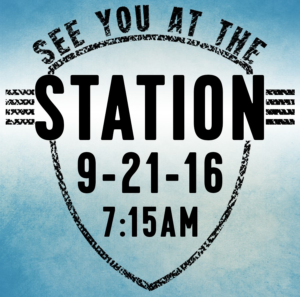 posted that simple idea on my Facebook page and within minutes had dozens of comments. A few hours later, I created a Facebook event page and titled it, “See You At The Station” in honor of the national, “See You At The Pole” rallies. In 36 hours, over 30,000 people had been invited. By the end of the second week, it had spread across the country to over 30 states. Our short window of 3 weeks, led to 65,000 people being invited in 35 states, hundreds of locations and thousands of people involved. Picture after picture after picture of people encircling their local police station gathered in prayer were posted the morning of the 2015 See You At The Station event. Pictures of groups of 1 or two people, dozens of people, and groups of hundreds were shared. For the people who came to pray or to be prayed over, I believe it changed them. For me, I know it forever changed me.
posted that simple idea on my Facebook page and within minutes had dozens of comments. A few hours later, I created a Facebook event page and titled it, “See You At The Station” in honor of the national, “See You At The Pole” rallies. In 36 hours, over 30,000 people had been invited. By the end of the second week, it had spread across the country to over 30 states. Our short window of 3 weeks, led to 65,000 people being invited in 35 states, hundreds of locations and thousands of people involved. Picture after picture after picture of people encircling their local police station gathered in prayer were posted the morning of the 2015 See You At The Station event. Pictures of groups of 1 or two people, dozens of people, and groups of hundreds were shared. For the people who came to pray or to be prayed over, I believe it changed them. For me, I know it forever changed me.
It is once again September. This month, we have two different opportunities to pray for our community. For those of us involved with SYATS, we still believe that the men and women who serve and protect us across the nation could use our prayer. So, I’m inviting you to come; pray. On Wednesday, September 21 at 7:15am wherever you live in whatever state, find your nearest police station and go pray for the men and women who work there. The following week, on Wednesday, September 28, students and their families across the country will be gathering at flagpoles before the start of school to pray over their campus and all who step foot there.
We often talk about wanting ‘Someone’ to ‘Do Something’. What if that ‘Someone’ is YOU? YOU could be somebody’s miracle. YOU CAN DO SOMETHING. Sometimes it requires feeling a little unsure; a little uneasy but taking a bold step of faith and courage to make a difference. You praying for these men and women might change them and impact their life, but if you let it, it might also change you and your life. Will you join with me and pray on Wednesday, September 21 at 7:15am, wherever you live, go to your local police station and just pray? I hope to See YOU At The Station too!
If you’d like more information about SYATS or want to share it with others, please check out the Facebook page: https://www.facebook.com/seeyouatthestation/
 Beth Armstrong is married to Chris, and they have 2 kiddos: Hunter who is almost seven and Ella who just turned two. I addition to her fulltime job, she has been a member of the Junior League of Waco for 13 years.
Beth Armstrong is married to Chris, and they have 2 kiddos: Hunter who is almost seven and Ella who just turned two. I addition to her fulltime job, she has been a member of the Junior League of Waco for 13 years.
The Act Locally Waco blog publishes posts with a connection to these aspirations for Waco. If you are interested in writing for the Act Locally Waco Blog, please email [email protected] for more
By Leilani Mueller
Three nights ago Felicity, my one-year-old daughter, tried running. She was wearing her long maxi-dress, with the ruffles around the top and the bottom. She tried with all her little might to run after her two-year-old friend who had a ball. Into the long grass, she went. The thick grass was taller than her knees. She stumbled on the grass and her skirt, but stood up again, and again. She tried so hard.
Three weeks ago she took her first step in California. Three weeks ago I was living in California. Not anymore.
People ask, “How do you like Waco? What do you think of moving?”
Putting into words the experience of moving is difficult. On the one hand, there is something so ordinary about it. Yesterday, I sang to my baby and put her to bed. This morning, I went for my mile run. I dropped Nathan off at school, carpooling, the same as we’ve always done. Yet, it is different. Here, Felicity has a room of her own. The brick buildings of the classically, beautiful Baylor campus put Makita Tool company’s white, rectangular office to aesthetic shame. And the air is thick here. It sticks to you when you run. You notice it. Three weeks is not enough time to really know what I think.
As I reflect, I wonder about the story I choose to tell about this place. I find myself wondering, can I determine my experience of Waco? (Clearly, I’m motivated by the fact that my husband is a philosopher) Over the past six months, when I told people I was moving to Waco a range of responses came my way.
“It’s the armpit of Texas.”
“Growing up here is the best.”
“It’s exciting.”
“I hate it.”
“I love it.”
And the one agreed upon thought: “It’s hot in the summer.”
One place manages to elicit a range of contrary emotions. Perhaps the place is just a backdrop. It is me who gets to decide who I will be in this place. And I can love it as much as the familiar streets of Harbor City, the eclectic eateries in Los Angeles, the winding pavement of Oxford. But to love it, is also to admit that it is not those other places. And it is OK to miss them. But it is also OK to love this place, which isn’t to be disloyal to the other places I belong.
My experience of Waco is a walking one. I try to run in this thick new grass, but I will stumble sometimes.
 Leilani Mueller is a wife, mother, teacher, and writer. Formerly, a California native she now calls Waco home. She loves YA novels, Shakespeare, Victorian literature, Baylor philosophy, and Pumpkin Spice Lattes.
Leilani Mueller is a wife, mother, teacher, and writer. Formerly, a California native she now calls Waco home. She loves YA novels, Shakespeare, Victorian literature, Baylor philosophy, and Pumpkin Spice Lattes.
The Act Locally Waco blog publishes posts with a connection to these aspirations for Waco. If you are interested in writing for the Act Locally Waco Blog, please email [email protected] for more information.
By Jenuine Poetess
I love a good play on words. I love community arts and culture. I also love a good celebration. So without further ado…*drumroll please*
CONGRATULATIONS WACO ON RECEIVING A UNANIMOUS VOTE TO BE DESIGNATED AS STATE OF TEXAS CULTURAL DISTRICT!!!! WOOOOOHOOOOOOOOO!
While I catch my breath you might be thinking, “Whooooo! Yay! But honestly, what does that even mean?” Great question, I’m so glad you asked! According to the Texas Commission on the Arts (TCA), our state arts agency, Texas has a cultural district program that, “can designate special zones [cultural districts] that harness the power of cultural resources to stimulate economic development and community revitalization. These districts can become focal points for generating businesses, attracting tourists, stimulating cultural development and fostering civic pride.” TCA recognizes that, “A thriving creative sector is a powerful economic development asset. Cultural district development is one strategy that helps a community boost economies while realizing other cultural and civic benefits. The outcomes of cultural districts extend beyond the arts and benefit all members of a community.”
There are a number of ways this designation will help Waco as a community as well as provide support and needed platforms for artists who are living and creating in Waco to continue our work and cultivate sustainable livings as artists. If I haven’t already made it clear, this is a HUGE win for Waco Arts and I am so proud to have joined so many others in the efforts to 1) create and sustain community-centered, inclusive, arts programming in our community and 2) be involved in the two-year Cultural District application process–directed by Fiona Bond of Creative Waco (You can read more about Fiona’s work with Creative Waco in an interview blog I wrote last year). It takes a village my friends, and this is definitely a moment to savor and celebrate. Oh, and did I mention that Waco ranked TOP in the state out of all the cities applying for Cultural District designation this year? Yep. We did.
In many ways, our work is just beginning…and certainly our work is continuing.
Last week many artists participated in #WorldArtDropDay in which we distributed art works all throughout the city leaving them—with FREE ART tags—for people to find and enjoy. Participation in this global project was inspired by Central Texas Artist Collective and in preparation, CTAC hosted several open community #artjam sessions at local libraries where for several hours people of all ages and artists of all disciplines could gather and create in a collaborative space with others. CTAC had a wonderful turnout of 15-20 artists join us over the two sessions and based on the requests and feedback from community, CTAC will likely host regular community art jam spaces so stay tuned for all the details there (on their website and at Twitter, Instagram, and Facebook @CenTexArtists). CTAC continues to foster creativity with the ongoing #ArtAbandonment project and is gearing up for their community booth at the 2016 Waco Cultural Arts Fest. The artists at the CTAC booth this year will be Christy Town; Carlos Arias; Rhiannon Rosenbaum; Angie Veracruz; Steve Veracruz; Jenuine Artworks; and When Brothers Draw.
Coming up this week, Waco celebrates the grand opening of the brand new Waco Hispanic Museum–a collection of arts and cultural artifacts honoring the rich Latinx history and community thriving in Waco today. The kick-off begins this Friday September 16th from 2:30-5:30pm with programming for all ages. On Saturday the festivities begin at 10am and go until 2:30pm. Located at the South Waco Community Center at 2815 Speight, this event is FREE and donations are appreciated. In addition to the museum exhibit, there will be performances, Gritos de Dolores, and a voter registration booth. For more information contact: [email protected]; 254-548-9730.
On Sunday September 25th from 4-8pm the Waco Hippodrome and Waco Poets Society presents Peace on the Patio a community open mic as part of the global project, 100Thousand Artists for Change. This year marks the fifth year Waco Poets Society has organized this event for our community. We are so grateful to our generous sponsoring venue, Waco Hippodrome for opening their patio to us for this event. Beginning at 4pm Ninth Limb Yoga, LLC will be 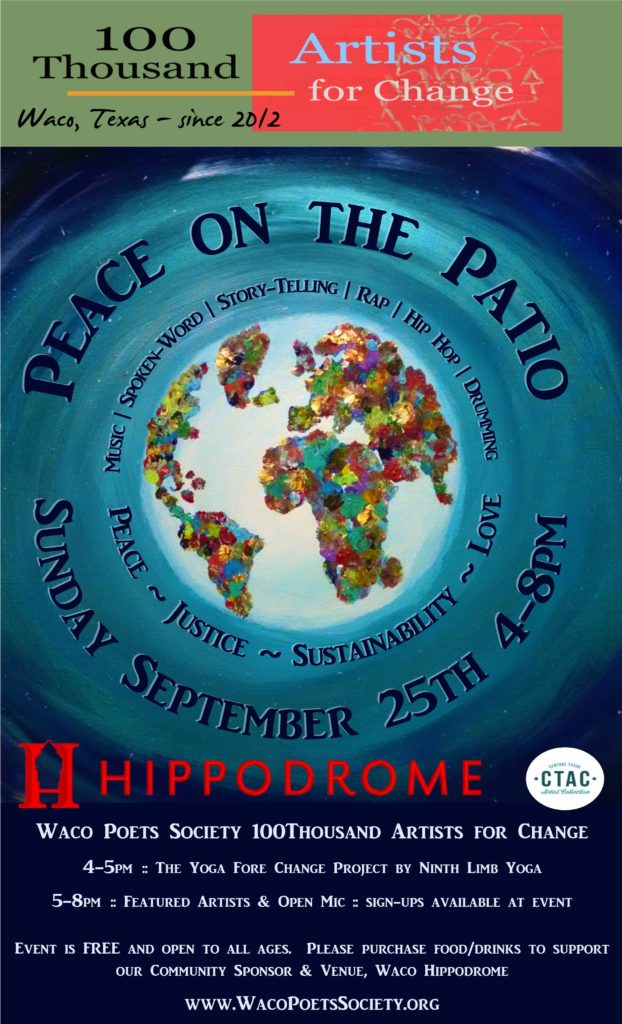 providing Yoga Fore Change Project yoga session ($5 suggested donation) until 5pm at which point the open mic, featuring singer/song writer, Katie Stewart, will begin. This year’s theme is Peace, Justice, Sustainability, and Love–so bring your songs, poems, stories, spoken-word pieces; bring your family, your friends, your neighbors, and co-workers. Purchase some delicious food and specialty drinks as a way of saying thank you and supporting a local business who gives back so faithfully to our community! Contact: [email protected].
providing Yoga Fore Change Project yoga session ($5 suggested donation) until 5pm at which point the open mic, featuring singer/song writer, Katie Stewart, will begin. This year’s theme is Peace, Justice, Sustainability, and Love–so bring your songs, poems, stories, spoken-word pieces; bring your family, your friends, your neighbors, and co-workers. Purchase some delicious food and specialty drinks as a way of saying thank you and supporting a local business who gives back so faithfully to our community! Contact: [email protected].
The 2016 WCAF, taking place in Indian Spring Park and the Waco Convention Center September 30th-October 2nd, looks to be a delightful array of music, visual art, dance and performance, poetry and writing, African film, and science for all ages. In addition to performances and interactive exhibits, art stations, and experiments, the festival draws a tasty selection of food vendors, vibrant artisan vendors, and authors from across Texas and beyond. (For complete schedules and full details on each festival please visit the links above).
This week a new exhibit opens at the Art Center of Waco and will be available for viewing now through October 22nd. While I Breathe, I Hope is a collection of abstract paintings by Caroline Lewis. Also at the Art Center are a number of classes open to community participants and weekly Cookies and Coloring sessions on Friday afternoons. Plan ahead and mark your calendars for the annual Fall Festival and Pumpkin Art Auction on October 29th—the theme for this year is Superheroes!
This post marks the two-year anniversary of me writing this monthly Arts and Culture blog, in honor of milestone, I’m starting a new hashtag…but more than a hashtag, I want to propel movement that has already been stirring in our community. Are you ready? Are you curious? Remember when I told you I love a good play on words? Well, here we go: #ArtLocallyWaco. 🙂 It seemed a completely natural conclusion especially when so many of us art (as a very active verb) locally, here in Waco.
If I’ve learned anything over the past 4+ years I have been creating and organizing arts programming in Central Texas, it is that showing up to the page, the canvas, the camera lens, the stage, the microphone, the textiles, the music, the wall, the materials—whatever they may be, the community is the single most important practice to have as an artist. Sure raw talent and honed skills are valuable. But what is vital for a thriving, creatively sustainable community, is at the very core so simple: it is we, showing up.
Sometimes that means to exhibit or perform, sometimes that means to set up and break down, sometimes that means lending a window or a wall as exhibit space, sometimes that means opening up your business as a performance or event venue, sometimes that means liking and sharing events on social media, sometimes that means our bodies physically showing up to be present, sometimes that means donating dollars to help financially sustain these powerfully effective community grassroots efforts doing remarkable good throughout our community, sometimes it is investing in local artists and writers buying their creations and books, sometimes it is advocating at city council or at the capitol or at the school board to ensure that funding and policy continues to make room for and protect the arts. What I love about community-centered arts and cultural programming is that there is room for every person of every age, every skill-level, every talent, every strength, every expression, every style, every medium.
So I put this challenge out to you—how will you #ArtLocallyWaco this month and beyond? Post in a comment, send us an email: [email protected], or tag us in your own social media post about how you will get or stay involved in the arts in Waco. I’m proud of what we are creating here in Waco, it is an ever-evolving, community collaboration and such a magnificent work of art!
 Jenuine Poetess is an artist, visionary, and community organizer. In 2010, she founded In the Words of Womyn (ITWOW), an international, grass-roots, written and spoken-word arts project with chapters throughout Los Angeles, CA; Waco, TX; and Lebanon. Jenuine is the founder of Waco Poets Society and co-founder of the Central Texas Artist Collective. She writes, organizes, and creates rooted in the fierce conviction that holding intentional space, access, and opportunity for all people to foster their creative health is a matter of justice and is a vital asset to the sustainable thriving of communities. She currently lives and poems in Central Texas where she enjoys finding new ways to disrupt the homeostasis of her city. You can contact her at: j[email protected].
Jenuine Poetess is an artist, visionary, and community organizer. In 2010, she founded In the Words of Womyn (ITWOW), an international, grass-roots, written and spoken-word arts project with chapters throughout Los Angeles, CA; Waco, TX; and Lebanon. Jenuine is the founder of Waco Poets Society and co-founder of the Central Texas Artist Collective. She writes, organizes, and creates rooted in the fierce conviction that holding intentional space, access, and opportunity for all people to foster their creative health is a matter of justice and is a vital asset to the sustainable thriving of communities. She currently lives and poems in Central Texas where she enjoys finding new ways to disrupt the homeostasis of her city. You can contact her at: j[email protected].
The Act Locally Waco blog publishes posts with a connection to these aspirations for Waco. If you are interested in writing for the Act Locally Waco Blog, please email [email protected] for more information.
By Rolando Rodriguez Soto
(This post is part of an on-going series about Downtown Waco. In a sense, Downtown is “everybody’s neighborhood.” In this series of blog posts we hope to contribute to the on-going conversation in Waco about what it takes to have a great downtown, and what we want for our own “Wacotown.” To see all the posts in this series, click here: Downtown Waco. – ABT)
When you hear the word “downtown,” what image pops into your head? Is it a successful commercial district complete with subways and skyscrapers? Is it a quaint collection of historic buildings and antique stores? Is it a thriving strip of restaurants, trendy shops and live music venues? Maybe the word “downtown” makes you think of concert halls, culture, and nice department stores? Or maybe the image in your mind is negative, one of boarded up buildings, graffiti, and crime.
More to the point for the purposes of this blog series, what image pops to mind when you think of Waco’s downtown? What do you like? What would you like to see? What would you like to see go away? How do we even get our minds around what we want in a downtown when there are so many possibilities?
Maybe one way to think about it is to try to come up with a list of the typical elements that make up a downtown and to think about where Waco is and where we want to be in respect to those elements. You may have your own list of elements in mind…here are a few of mine:
Residential
Imagine waking up on a Monday morning and looking out your window to see storefronts, busy sidewalks and the ALICO building. After getting ready for the day, you go down a few flights of stairs, go next door to your favorite coffee shop to get your fix and then you walk a few more blocks to the office to start your work day.
Waco offers Some unique possibilities when it comes to downtown living. Luxurious lofts, historic buildings and apartments overlooking the Brazos river are just a few of the options.
The former Waco High School campus on Washington Ave. and the former Waco Independent School District alternative school campus were recently transformed into loft apartments that still retain the historic look. You can still find lockers and white boards in the Waco High Lofts building to remind residents of the building’s life in the 20th century.
The redefined downtown residential life is perfect for college students, young professionals, and empty-nesters who are eager to take advantage of a new form of living, which will breathe life into downtown.
Commercial
Business is another crucial element of a thriving downtown. In previous years, many major department stores and restaurants began moving away from downtown to be near highways or in malls. This unfortunately left downtown with deteriorating and empty storefronts, which did not exactly make living in downtown desirable.
Recently, new businesses have begun to reassess the value of a downtown. Waco currently offers restaurants, coffee shops, office space, boutiques and antique shops in its downtown space.
As we continue to expand and add more commercial opportunities, Waco will be able to generate more employment and tax revenue prospects, which will attract new residents and creative thinkers.
Amenities
So far, you have enjoyed your relaxing apartment, your walk to work and some fun shops and restaurants in between, but now after a long day in the office, you want to go out and do something fun. A strong downtown environment should be able to offer nightlife, culture, recreational activities and community events, so that there is a reason stay in the center city.
Events or activities such as a farmer’s market, art festival, concert, block party, weekly or monthly events or a special movie screening all contribute to a fun environment where residents can expect to find one central location that features work and play.
These types of events and activities are almost expected in downtown environment. Fortunately, Waco also offers unique amenities you most likely won’t find anywhere else such as the Magnolia Market at the Silos, the Waco Hippodrome Theatre, Balcones Distillery or the Art on Elm Festival.
In a commercial district where buildings and streets take charge, it is important to recognize and appreciate nature. Fortunately, any street in downtown can lead you to the beautiful Brazos River, Indian Spring Park featuring the Suspension Bridge, or Cameron Park with its hiking trails and Cameron Park Zoo.
Transportation
We have defined the three major elements that reflect daily life—relaxation, work and play. Now how do we connect the dots?
A major benefit of a centralized downtown location is walkability. Not only do residents have the benefit of walking from home to work or other stores, restaurants or events, but also they benefit the environment by reducing their carbon footprint.
Exploring everything downtown has to offer is more enjoyable on foot because you are able to appreciate each store front and historical piece at a slower pace.
In its current state, downtown does not have the most traversable streets and sidewalks, but the city of Waco has improved over the years through the addition of bike lanes, larger sidewalks and shuttle services.
Streets in Waco may seem simple to someone who has lived here all of their life, but to anyone else, the streets can be confusing with their oddly timed traffic lights and one way streets.
Technology is beginning to help make navigating downtown easier. We can access bus routes and directions with our navigation apps on our phones, and we can even call a car service with another app. But, creating a pedestrian friendly environment is crucial to establishing a welcoming downtown where a Wacoan can walk from their loft to work, their favorite coffee shop, the movie theatre or the park.
Have we fully realized the potential for downtown Waco? I hope not. I hope to see downtown continue to grow and thrive. Who knows? Maybe one day we will even have more than one skyscraper!
 Rolando Rodriguez Soto was raised in Waco, TX, and he is currently attending Baylor University with plans to graduate in December 2016 with a Bachelor of Arts in Professional Writing & Rhetoric. After graduation, he hopes to work in Waco in the nonprofit sector to help realize the full potential of Waco. His long term goals include hopefully creating and publishing creative work whether that is a novel, short story or even a television show.
Rolando Rodriguez Soto was raised in Waco, TX, and he is currently attending Baylor University with plans to graduate in December 2016 with a Bachelor of Arts in Professional Writing & Rhetoric. After graduation, he hopes to work in Waco in the nonprofit sector to help realize the full potential of Waco. His long term goals include hopefully creating and publishing creative work whether that is a novel, short story or even a television show.
The Act Locally Waco blog publishes posts with a connection to these Aspirations for Waco. If you are interested in writing for the Act Locally Waco Blog, please email [email protected] for more information.
(Act Locally Waco loves Waco area entrepreneurs! For more posts about local entrepreneurs, please click here: Entrepreneurs of Waco. If you would like to nominate a Waco entrepreneur to be profiled, please email [email protected]. – ABT)
By Penni Litzau
“In my work as a business advisor for the Small Business Development Center I enjoy working with all types of small business owners every day. From time to time I run across a true craftsman/craftswoman and the business is only necessary to provide the framework for them to share their craft with the world. Penni is one of those craftswomen.” – Tim Holtkamp, Business Advisor, McLennan Small Business Development Center
Hello, I’d like to introduce myself! My name is Penni Litzau, and, many years ago, I fell into a love affair with the art of custom framing. I first became acquainted with custom framing in the mid-80’s, and it opened up a whole new world for me. I had never even heard of custom framing, didn’t know what it was. As far as I knew, people just bought pictures and they were already framed in some magical way.
Up until that time, my sum total of work experience had been in daycare and fast food. Even though I enjoyed working with customers and the direct contact with the public, I had become less than excited about things like inordinate amounts of grease, and I remember coming home feeling covered in it.
So, I began the hunt for a new job. I knew I was intrigued by the world of retail, and that became my new emphasis. I remember applying for a wide variety of jobs—everything from selling candles to high-end clothing sales. Then, I saw an ad at the employment commission for seasonal work at Old America in Clute, Texas.
When I submitted my application for the job, I was asked if I knew how to read a tape measure. I said I could, and after a few successful tries at measuring an assortment of objects, the job was mine. Though I didn’t know it at the time, this “seasonal” work would grow into full time.
From that point on, I was hooked. I was amazed at how many different directions you could follow to create a piece of art. I was mesmerized by the entire process—from working with each individual object and using my own imagination to presenting every new customer with a final product that was displayed for them in the best way possible. I was giving something precious—a memory, a photo, handmade artwork, sometimes even a shadow box—that could be enjoyed for years to come.
In my very first encounter with the art of custom framing, I questioned the customer as to what thoughts they had and what direction they wanted to go with their print. I was not prepared for the response. “Well, you’re the expert; why don’t you tell me?” My initial thought was that they were my first customer and I wasn’t sure I would be able to give them what they expected.
Right then and there, I made a decision. I figured if I acted like I’d been doing this for years, it would create a level of trust in me. And, boy, did I want this to work, both for them and for myself. I took the work in hand and prayed that I would be successful in making them happy and in creating something special.
Happily, my first run at it turned out to be exactly what they were looking for. It was a wonderful experience for them and for me. From then on, I knew that, somehow, I had an innate understanding of what it took to create something like this. Most importantly, it was something I could be proud of.
In the end, I had to give up that job because I had to move away. There followed a succession of years in which I had to leave my new-found love for a time and work once again in fast food. I had to pay my bills, and at that time, framing only paid minimum wage, regardless of one’s level of expertise.
In all affairs of the heart, there are many twists and turns before the happy ending, and mine was no different. I explored numerous other paths, seeking education and better pay. I made a move to Waco, Texas, to be closer to my family. Eventually, I married, and my husband, Stephen, and I began a blended family.
After working several years pursuing a potential career in electronics, I found I was still unhappy due to the lack of artistic expression. My husband and I decided that I would leave work for a period of time and spend more time with our growing family. Later, after the kids went back to school, I returned to the work field.
Throughout the years, I had longed to return to framing, so I applied to the two chain stores with frame shops in Waco, Michaels and Hobby Lobby. Miraculously, when I walked into Hobby Lobby and told them I had a background in framing, they told me there was a position needing to be filled in their frame shop. I got hired on the spot!
For the next sixteen years, I worked in framing, and, finally, realized it had become my passion. After all these years, I found myself not only loving what I was doing but slowly progressing to a better living wage. Beyond all doubt, framing was the perfect career I wanted to pursue.
So now, the time has come to end one story and begin the next. It is an exhilarating, almost breathtaking experience to start my own business doing what I love the most. But, you know what they say, “If you do what you love, and you will never work a day in your life.”
I’m looking forward to this new, next journey—that of helping people preserve their special artwork, personal memories and experiences in the best way possible. Through the use of specialized framing techniques and artistic expression, I know I can make your next memory one that will last you a lifetime.
Penni Wise Custom Framing is located at 7033 Sanger Avenue in Waco, Texas, right on the access road of Highway 6. My hours of operation will be Tuesday through Friday 9:30 AM to 5:30 PM and Saturday 10:00 AM to 2 PM. I will be open the first week in September with an official Grand Opening October 1st, 2016. Please come and visit. I would love to meet you and together create a thing of beauty.
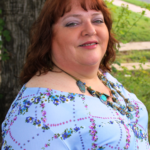 Penni Coleman Litzau was born in San Antonio, Texas and has spent the majority of her life in Texas. She attributes, in part, her eye for detail to being raised by a mother who lost her eyesight due to Multiple Sclerosis. Penni became her “mother’s eyes” and described everything she saw in great detail and vivid color. In 1996, she moved to Waco, Texas to be closer to her mother, sister, and family. A year later, Penni met her husband Stephen Litzau, the Millwork Supervisor and longtime master craftsman for CM Trautschold. They blended their family in 1998. You can contact Penni through email at [email protected] , www.penniwisecustomframes.com , or facebook.
Penni Coleman Litzau was born in San Antonio, Texas and has spent the majority of her life in Texas. She attributes, in part, her eye for detail to being raised by a mother who lost her eyesight due to Multiple Sclerosis. Penni became her “mother’s eyes” and described everything she saw in great detail and vivid color. In 1996, she moved to Waco, Texas to be closer to her mother, sister, and family. A year later, Penni met her husband Stephen Litzau, the Millwork Supervisor and longtime master craftsman for CM Trautschold. They blended their family in 1998. You can contact Penni through email at [email protected] , www.penniwisecustomframes.com , or facebook.
By Hannah Parrish
 This summer, I planned, implemented, and evaluated a five-week worksite wellness program called BEAT THE HEAT for the staff of the Waco-McLennan County Public Health District (WMCPHD). I am graduating from Baylor University this August with my bachelor’s degree in Public Health. As a part of my summer internship, I was given the opportunity to connect my studies to public health practice. My experience with BEAT THE HEAT has allowed me to grow in my understanding of public health in many ways, but it has specifically taught me the importance of worksite wellness programs.
This summer, I planned, implemented, and evaluated a five-week worksite wellness program called BEAT THE HEAT for the staff of the Waco-McLennan County Public Health District (WMCPHD). I am graduating from Baylor University this August with my bachelor’s degree in Public Health. As a part of my summer internship, I was given the opportunity to connect my studies to public health practice. My experience with BEAT THE HEAT has allowed me to grow in my understanding of public health in many ways, but it has specifically taught me the importance of worksite wellness programs.
According to The Centers for Disease Control and Prevention (CDC), worksite wellness programs can help “maintain and improve the health of employees,” and they can also reduce the employees’ risk of developing “costly chronic diseases” (WH 101 Resource Manual). According to the Worksite Health 101 Resource Manual developed in partnership by Viridian Health Management LLC and the CDC in 2016, a healthier workforce can lead to “lower direct costs such as insurance premiums and workers’ compensation claims,” and it can also “positively impact many indirect costs such as absenteeism and worker productivity” (WH 101 Resource Manual).
The worksite wellness program, BEAT THE HEAT, was designed with the mission to equip the employees of the WMCPHD with the tools and resources necessary to promote total wellness in their daily lives. On a broader scale, BEAT THE HEAT offered accountability, motivation, and education to the staff of the WMCPHD in an effort to instill long-term practices of wellness. BEAT THE HEAT carried out these missions through a period of five-weeks, and the program included motivational, educational, and accountability components. The program allowed the employees of the WMCPHD to focus on several dimensions of wellness, and encouraged them to make daily choices that would “add up.” The employees were provided weekly activity logs, and each activity focused on a different dimension of wellness. A certain number of points were designated to each activity on the log, and the activity logs changed week to week. By the end of the five-week program, the top five individuals with the most points earned chose their prizes.
I partnered with local businesses, The Mix Café, Oh My Juice!, and D1 Sports Training, to ensure that nutritionally and physically healthy prizes were offered to program participants as incentives. BEAT THE HEAT was marketed through the use of informational and motivational flyers, which were administered to the staff of the WMCPHD to generate interest. About half of the WMCPHD participated in the program, which doubled my initial goal of reaching twenty participants. Here’s what a few participants had to say about the program:
“This program encouraged me to add different wellness activities into my daily health regimen…activities that I would not normally participate in on my own.” – Janet Jones
“I have definitely gained a lot from the past 5 weeks, even though I consider myself a pretty healthy person to begin with. This program has been great because everyone can gain something from it. BEAT THE HEAT made me more intentional about some aspects of wellness that often get overlooked, such as getting enough sleep and drinking enough water. Knowing that you’re going to have to submit your points at the end of the week is a great motivator. I would start trying to talk myself out of a workout and then remember – I need those points!” – Katy Stone
My experience with the BEAT THE HEAT wellness program has taught me the importance of planning, implementing, and evaluating wellness programs in every workplace. I learned that wellness is only truly achieved when every dimension is viewed as an impacting factor. In 2015, about 70% of employers in the United States offered a “general wellness program” in their workplace (Forbes). While this estimation is higher than I predicted, there is always room for growth in the areas of specificity and goals of these programs. Does your worksite incorporate a monthly, quarterly, or yearly wellness program? If not, now is the time to start. Many worksites have a wellness coordinator to create wellness programs for employees. If you are interested in some ideas for wellness programs, the DSHS has compiled a list here. Many worksite wellness programs focus on physical and nutritional wellness; I decided to include every dimension of wellness in BEAT THE HEAT because every factor is important and contributes to our total wellness.
Finally, through my experience, I learned that creativity is key, and each person is different in their interests; these realizations made for a diverse program. I thoroughly enjoyed planning, implementing, and evaluating the BEAT THE HEAT wellness program for the staff of the Waco-McLennan County Public Health District!
 Hannah Parrish moved to Waco in August 2013 to attend Baylor University. She received her degree in Public Health from Baylor in three years, and had the opportunity to intern at the Waco-McLennan County Public Health District during her final summer in Waco. She loves traveling, fitness, community, coffee, and reading. She hopes to spend the next year teaching English overseas, and subsequently attend nursing school.
Hannah Parrish moved to Waco in August 2013 to attend Baylor University. She received her degree in Public Health from Baylor in three years, and had the opportunity to intern at the Waco-McLennan County Public Health District during her final summer in Waco. She loves traveling, fitness, community, coffee, and reading. She hopes to spend the next year teaching English overseas, and subsequently attend nursing school.
The Act Locally Waco blog publishes posts with a connection to these Aspirations for Waco. If you are interested in writing for the Act Locally Waco Blog, please email [email protected] for more information.
